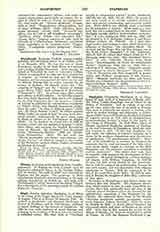

Stanyhurst, RICHARD, Catholic controversialist, historian, and devotional writer, b. at Dublin, 1547; d. at Brussels, 1618. He was the son of James Stanyhurst, speaker of the Irish House of Commons and a leading Dublin Protestant. After leaving his school at Waterford he went to University College, Oxford, becoming B.A. in 1568, and then studied law in London. At Oxford he had met Bl. Edmund Campion, and he accompanied the latter on his visit to Ireland, helping him to collect material for his history of Ireland. He himself wrote the “Description of Ireland” and the “History of Ireland under Henry VIII“, both published in Holinshed’s “Chronicles”, 1577. In several ways these works gave offense to Irish Catholics. In 1579 Stanyhurst’s first wife, Janet Barnewall, died, and he left England for the Low Countries, where he became a Catholic. At Leyden he published his extraordinary translation of Virgil’s Aeneid into English hexameters (1582). Later he wrote “De rebus in Hibernia gestis” (1584) and “De Vita S. Patricii” (1587). In 1585 he married Helen Copley, by whom he had two sons, both afterwards Jesuits. Subsequently he spent some years in Spain as adviser to the Government on English affairs. On the death of his second wife, in 1602, he became a priest and was appointed chaplain to Archduke Albert, also assisting the English Benedictine nuns at Brussels. He published two devotional works, “Hebdomada Mariana” (1609) and “Hebdomada Eucharistica” (1614). His last work was “Brevis praemunitio pro futura concertatione cum
Jacobo Usserio”, in which he replied to the treatise of his Protestant nephew, James Ussher, afterwards Archbishop of Armagh.
EDWIN BURTON

